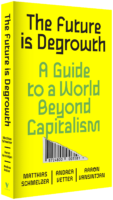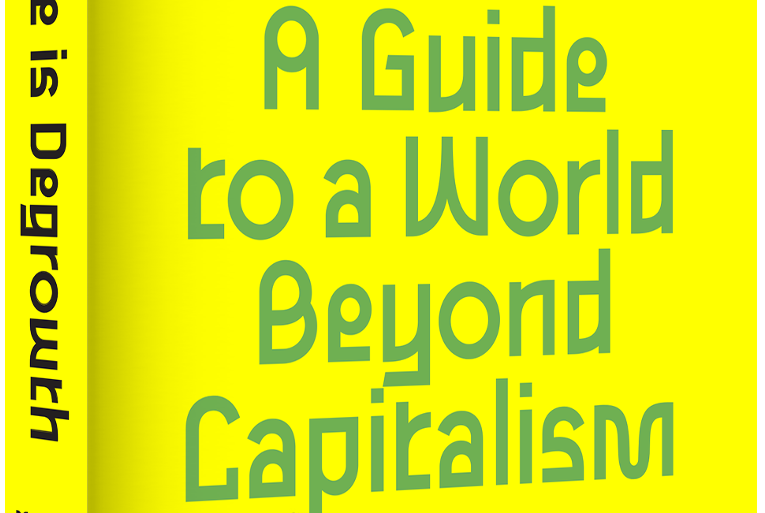 As the flaws in the currently prevailing paradigm of unfettered growth become ever more apparent, degrowth is increasingly regarded as a tangible alternative. Far from a radical notion confined to the realm of abstract debates, it may hold the key to a more just and sustainable world. An ambitious new book, The Future is Degrowth: A Guide to a World beyond Capitalism (Verso, 2022), sets out to be a roadmap towards a future without growth.
As the flaws in the currently prevailing paradigm of unfettered growth become ever more apparent, degrowth is increasingly regarded as a tangible alternative. Far from a radical notion confined to the realm of abstract debates, it may hold the key to a more just and sustainable world. An ambitious new book, The Future is Degrowth: A Guide to a World beyond Capitalism (Verso, 2022), sets out to be a roadmap towards a future without growth.
The climate breakdown, the growing gap between the wealthiest and the poorest, the gap between the Global North and South, and the ongoing pandemic have proved that the mainstream growth-based economic model is not fit for purpose. But what is the alternative?
The pandemic turned out to be a major moment for the degrowth debate. On the one hand, advocates of economic growth used lockdowns as evidence of what a degrowth society might look like, even though our growth-dependent economic model was at least partly responsible for driving the pandemic. Degrowth supporters, on the other hand, took the opportunity to clarify their proposal and stress the urgent need to move to a post-growth economy. Degrowth entered the mainstream debate like never before. As scholar Timothée Parrique shows, it is even present in the most recent Intergovernmental Panel on Climate Change report.
The critique of an economic system based on economic growth is not new. In 2022, we celebrate the 50th anniversary of the seminal report The Limits to Growth. Published in 1972, a team of scientists led by Donella Meadows warned that the resource consumption of an ever-growing economy was unsustainable. In the decades since, various alternatives to a growth-based economy have been put forward including a steady-state economy, post-growth, doughnut economics, and degrowth.
The differences between these proposals are not only semantic. Though they may overlap, they represent different visions of how radical the change should be, the role of politics and the conflict between bottom-up and top-down approaches, and the kind of measures they imply. Where they agree is in their essential criticism of an economy based solely on economic growth. Such a model is seen as both doomed to fail given the planet’s limits, as well as underpinning an unjust social and geographical distribution of wealth.
The Future is Degrowth: A Guide to a World beyond Capitalism by Matthias Schmelzer, Andrea Vetter, and Aaron Vansintjan is part of this wider effort to provide fair, ecological, social, and economically sustainable alternatives to a growth-dependent economy. It does so magnificently. The affirmative title is clear regarding the authors’ intent: they have a clear alternative to the present and a clear idea of the future this “guide to a world beyond capitalism” can bring about. But to properly justify why an alternative to the present system is required, it is necessary to explain why the existing situation is not sustainable. The book can thus be divided into two parts: the first half on economic growth and its limitations and the second presenting the degrowth alternative.
The unsustainability of economic growth
The book opens with two chapters dedicated to the definition of economic growth, its main attributes, and different critiques of growth. The subchapter “Defining degrowth” appears only on page 191, as if the authors really wanted to make sure that the reader understands why a growth-dependent system is no longer viable.
In the first of the two chapters dedicated to the concept of economic growth, the authors discuss the growth paradigm and how it has become hegemonic to the point that “growth appears as an unquestionable, positive value at the centre of a network of ideas and everyday common sense”. This value acts both to justify and silently coerce “people into contemporary relations of power and hierarchy – including social relations of production such as wage work”.
The second chapter is dedicated to seven critiques of growth: the ecological, socio-economic, cultural, and feminist critiques, along with the critique of capitalism, the critique of industrialism, and the South-North critique. The authors detail the different arguments, exposing different positions within them. For example, within the broader sustainability debate, degrowth supporters are said to be “more amenable to a critique of capitalism than steady-state economy or post-growth proponents”.
The joint consideration of these critiques is essential both to ensure an effective response to multiple crises but also, as the authors warn, to avoid (extreme) right-wing appropriation of degrowth and its ideas. For while the political right mostly supports a growth-oriented policy, there is also a reactionary critique of growth on parts of the ethnonationalist right. This faction argues that, as the availability of resources falls, overall consumption must fall but their people must have continued access. Clearly, this line must be rejected by those supporting degrowth as it is conceived in this book.
The degrowth alternative
Having thoroughly explained the problems with growth, the authors move on to the alternative. But what is degrowth? For the authors, more than a strictly defined concept, degrowth is “a movement in motion” that “should be considered an umbrella term for various movements and frameworks on the left”. It is clear that this book, intended as a guide, is written for people on the left. Acknowledging the existence of a productivist left, the authors defend the position that degrowth can – and should – be adopted by ecologists and those on the left. While ecologists might be easy to convince, the latter represent a greater challenge.
The second part of the book looks at understanding degrowth and how to get there. Four chapters are dedicated to degrowth visions, the pathways to degrowth, making degrowth real, and the future of degrowth. The authors revert to the three criteria for evaluating social alternatives developed by Erik Olin Wright – desirability, viability, and achievability– and dedicate a chapter to each one.
The first explains the desirability of degrowth and focuses on degrowth visions, clarifying that it is a contested and multivalent concept tackled differently by degrowth’s various currents. Those currents are, first, the institution-oriented current; second, the sufficiency-oriented current; third, the commoning, or alternative economy current; fourth, the feminist current; and, fifth, the post-capitalist and globalisation-critical current. Despite the differences, the authors argue that the overlap between them makes it possible to see these strands as “currents in a turbulent stream, each of them with their own characteristics but traveling in similar directions.”
It is an integral part of degrowth’s definition that it does not necessarily mean less, but rather, and mostly, different. This book presents three principles of degrowth that underpin its translation as a concrete transformation: 1) global ecological justice, 2) social justice and self-determination, and 3) redesign of institutions and infrastructure. Degrowth’s major challenge thus relieves itself in that third point: a “prerequisite for a degrowth society would therefore be to restructure all relevant social institutions in such a way that they can function without economic growth, or to create new growth-independent institutions that can fulfil the functions of the existing ones.”
It is important to note, as the authors do, that the required changes are not only economic or political. In addition, potentially even more challenging changes at the psychological level will be required as well. As Georgios Kallis, a renowned degrowth scholar, shows in his book Limits, the mental infrastructures regarding consumption, accumulation, and growth depend on location and historical time. While in a given historical and social context, there might be a common understanding that a growth-dependent economy is part of our lives, there are plenty of historical examples of different common understandings. A degrowth future is therefore possible and also may depend on a mental infrastructure perspective.
Chapter 5 discusses the viability of degrowth, outlining six pathways: (1) the democratisation of the economy, or, the strengthening of the commons, a solidarity-based economy, and economic democracy; (2) social security, redistribution, and caps on income and wealth; (3) convivial and democratic technology; (4) the redistribution and revaluation of labour; (5) the equitable dismantling and reconstruction of production; and (6) international solidarity. The focus is mainly on policy but the authors clarify that change nevertheless depends on the combination of “collective action, grassroots change, and policy reforms”.
The book then moves on to the question of degrowth’s achievability, the feasibility of making degrowth a reality. Once again, the authors return to Olin Wright and his three transformation strategies: 1) “interstitial strategies” (existing alternative institutions such as cooperatives or community-based organisations), 2) “symbiotic strategies” (forms of cooperation between different social forces and representatives of the political system) and 3) “ruptural strategies” (revolutionary confrontation). While the third route is rare in the degrowth debates, the interstitial and symbiotic strategies are often discussed and “regularly juxtaposed”.
For the authors, the achievability of degrowth depends on a balance between policy-oriented top-down proposals (for example, the reduction of working hours or maximum income) and bottom-up, small-scale alternatives and self-organised projects that function without or even against the state. This conclusion is particularly relevant for political ecology, as it would propose a way forward regarding a transformational strategy that can bring together green NGOs, citizens, and political parties.
The future is degrowth
As the subtitle says, this book is indeed a guide. But it is much more than that: it is a solid analysis of the faults of a growth-based economy, an overview of the different approaches opposing this model, and how they converge (or not) in their goals. Written at a timely moment, this book is both for those just coming across the idea of degrowth, as well as those already familiar with the term.
The Future is Degrowth is arguably one of the most complete works on the concept of degrowth, clearly and thoroughly discussing the need to think beyond economic growth and why and how degrowth is an alternative. Yes, degrowth is both a “provocation” and a utopian project, but it is also something desirable, viable, and achievable. This book is essential reading for both actors within civil society movements and policymakers, as it manages to be extremely ambitious in its goals while remaining realistic. It offers the tools to build a new hegemony based on ecological sustainability and social and economic justice.
The book ends with several topics that deserve deeper discussion as part of the conversation around degrowth, such as class and race, geopolitics and imperialism, and information technology. These prompts are proof that the debate around degrowth can and must continue. An alternative future is possible; it is up to us to make it a reality. Is degrowth that future? Many features of the current moment, from secular stagnation to geopolitical worries over energy security, from demographic ageing to extreme inequalities, point to some form of degrowth (managed or unmanaged) as the solution and thus as the future. The challenge is now to define politics that can handle those changes in a just and democratic way. This book offers a clear guide.





